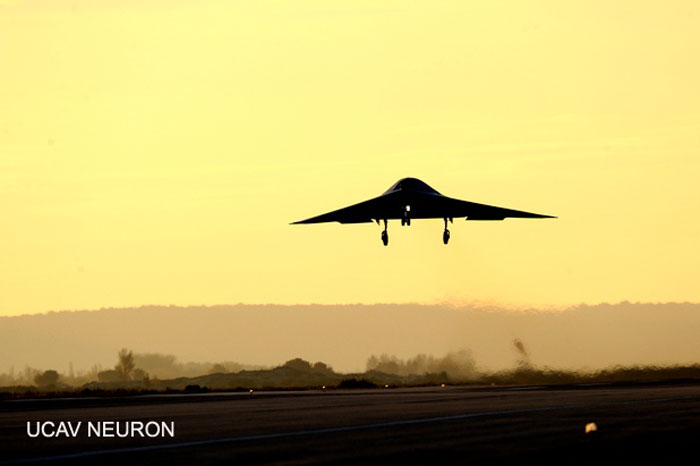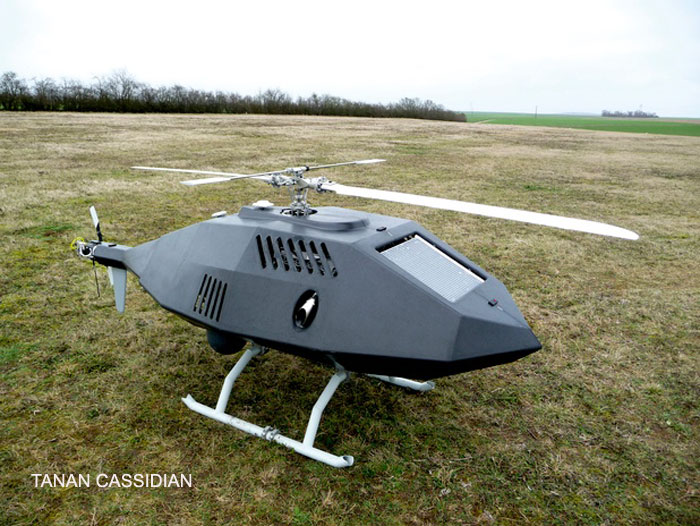-

Europe's Neuron unmanned combat aerial vehicle (UCAV) is as much a political marvel as a technological one.
Led by the French defense armaments agency DGA and prime contractor Dassault Aviation, the technology testbed aims to demonstrate both the airworthiness of a stealthy combat air vehicle and the ability to develop, build and flight-test the UCAV with a relatively limited €405 million ($500 million) budget across six European countries with multiple industrial partners.
Initiated in 2003, Neuron is 50% financed by France, with participation from Italy, Sweden, Spain, Switzerland and Greece. In addition to technology development, the UCAV aims to demonstrate a leaner decision-making process that eliminates the procurement complexities that have plagued other international collaborations, such as the Eurofighter Typhoon. For Neuron, Dassault coordinates industrial interests and interacts with DGA, which is responsible for coordinating the governments' collective position.
Neuron completed its maiden flight Dec. 1 from the Istres test center in southern France, marking the first flight of a European UCAV and the first demonstration of European stealth technology, paving the way for upcoming flight testing in Italy and Sweden.
Designed to attack relocatable targets, such as “double-digit” air defense systems and mobile ballistic missiles Neuron can autonomously transmit imagery to an operator on the ground who can then clear the vehicle to return and strike.
During the 25-min. flight, Neuron climbed as high as 7,000 ft. and reached a top speed of 200 kt. The landing gear remained down for the flight, during which Neuron was tailed by a twin-seat Rafale fighter for safety.
Powered by a Rolls-Royce Turbomeca Adour engine, the 10-meter-long (33-ft.) Neuron has a wingspan of 12.5 meters and a dry mass of 5,000 kg (11,000 lb.). It is designed to operate for up to 3 hr. at a maximum altitude of 10,000 ft., achieving speeds up to Mach 0.8.
As a technology demonstrator, Neuron is not intended to enter serial production, though France and U.K. are both eyeing future air combat systems. Earlier this year the U.K. Defense Ministry awarded Dassault and BAE Systems an 18-month study contract aimed at developing technologies for a potential joint UCAV that could be operational by 2030.
Meanwhile, Neuron addresses a number of technological challenges for future combat aircraft in Europe. The vehicle incorporates Dassault's radar-absorbent materials and structures into the airframe edges and inlet lips and demonstrates stealth-compatible air data systems. Alenia Aermacchi's internal weapons bay development is the first in Europe since the Breguet Atlantic maritime patrol aircraft of the 1950s. Italy, which is contributing about €74 million to Neuron, also produced the electro-optical/midwave infrared targeting system developed by Selex Galileo. Based on mercury cadmium telluride (MCT) detector technology, it is installed behind a large flush window and provides a field of view of more than 90 deg. with a stabilization system for high resolution at long range.
Sweden's €74 million contribution funded the central and forward fuselage, landing gear doors, fuel system and avionics, all developed by Saab, while Spain's €34 million supplied the EADS CASA-built wing, data-link integration and ground station. Switzerland provided €17 million for the Ruag-built weapons interface and Greece's €4-million contribution includes Hellenic Aerospace Industry's rear fuselage, exhaust duct and other components.
With the initial flight test complete, Neuron is to undergo radar cross section trials at DGA's Centre de l'Electronique de l'Armament near Rennes. With 150-200 fight tests planned, trials will resume in April at Istres, where Dassault expects to progressively open Neuron's flight envelope. Beginning in 2014, operational trials in Sweden and Italy will pit Neuron against live air-defense sensors, culminating in a weapons-drop test at the Perdadesfogu range in Italy.
-

Despite the large inventory of unmanned aircraft deployed among European armed forces, many countries are still trying to define their long-term surveillance needs.
That picture could start to come into sharper focus in the coming months, as a series of political uncertainties are removed and tests of various systems are completed. Although they are not billion-dollar contracts, at a time of fiscal austerity in many European militaries, the pending decisions carry significant weight for unmanned aircraft providers as they try to secure deals.
That complexity of fielding new systems is exemplified by the U.K.'s effort to introduce the Watchkeeper tactical unmanned aircraft into service. The program has suffered repeated delays, and Defense Ministry officials are no longer providing a specific projection about when it will be fielded.
Once operational, Watchkeeper, the Thales-run effort to upgrade the Elbit Systems Hermes 450, is expected to be deployed quickly to Afghanistan, where the British army is relying on Hermes 450s provided through a service contract. Much effort is being expended to ensure that Watchkeeper will be fully mature when it is fielded to avoid a reduction in drop-in intelligence-gathering capacity when it replaces the Hermes 450, says Brig. Alan Hill, the British Army's head of information superiority. The Hermes 450 will be gradually withdrawn from service as larger numbers of Watchkeepers come online this year.
Although much of the focus has been on putting intelligence-collection systems into inventory, military planners in Europe are starting to look at a broader range of capabilities. For instance, after last year's air war over Libya, the French air force says it recognized that “the weaponization of UAVs will be vital.”
France has been trying to determine its unmanned aircraft plans for several years. The government decided last year to field the Heron-TP, offered through Dassault Aviation, as an interim measure, with Dassault and BAE Systems cooperating on the Telemos unmanned aircraft as the long-term, medium-altitude, long-endurance unmanned vehicle. Contracts have not been signed for either, though, and the new French government under President Francois Hollande has yet to announce its policy on the issue. Resolving those matters will also depend on parliamentary elections this month.
Moreover, a senior French industry official points out that the government is expected to issue a new strategic white paper and budget plans.
EADS, which had competing offers for both the interim UAV program in France and the long-term MALE project, is holding out hope that the political changes may reopen the door for it to participate. Modernizing the existing Harphang system, the EADS-provided equipment based on Israel Aerospace Industries' Heron 1, could be an option instead of the Heron-TP. Some French legislators have also argued Paris should simply acquire General Atomics Reaper unmanned aircraft.
Switzerland is also sorting out UAV plans for its army. The government will conduct a flyoff between the Elbit Systems Hermes 900 and Heron 1, with a type selection due in the first half of 2014 to replace the Ruag Aerospace ADS 95 Ranger, which is reaching the end of its service life. The purchase of six air vehicles and associated equipment is slated to be part of the 2015 armaments spending plan, with a 2017 in-service date.
The Swiss would use the system only for intelligence, surveillance and reconnaissance missions, with no current plans to arm the UAV. The system will be operated by the Swiss air force, which will be involved in the type selection along with the Swiss armaments agency.
Another area of interest is how countries will field vertical-takeoff-and-landing unmanned air vehicles (VTUAV). The U.K. is seeking an over-the-horizon surveillance capability for the Royal Navy, and France is looking at its long-term needs. Schiebel's S-100 Camcopter has been used heavily during demonstrations, and company CEO Hans Schiebel says, “since we are the only system in the market and the most mature system, we have a very good market position.”
Still, many navies have signaled that the S-100 may be too small for their long-term needs, driving Schiebel to work on a larger system it hopes to be able to deliver next year.
Others have their eye on that segment, too. Saab is working on its Skeldar system and Indra has begun flight tests of its Pelicano unmanned aircraft. The Spanish company plans to complete ship integration work this year. It is targeting the 6-hr.-endurance system for use from frigates and patrol boats.
EADS is betting on its 300-kg. (260-lb.) Tanan VTUAV aimed at both navy and army users. One of its key features is a heavy fuel engine, notes a company official. Flight trials are underway.
Quelle:aviation-week
5941 Views

